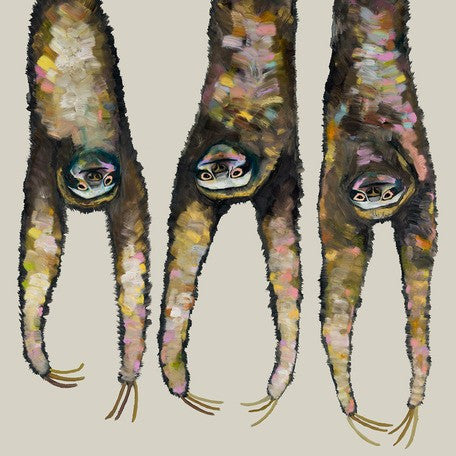A Slice Of Sloth
I’ve a goodly slice of sloth.
Not total self, but there it is,
A chunk disguised,
Not recognized by those around,
But I, I see it, know it,
Bowing, yes, kowtowing to it.
Here I sit admitting it
To get it off my chest and onto paper.
Much below the conscious,
Goodness knows
Why one must beep a caper
Steeped in bloopers
Onto paper.
Definitely didactic -
(I’ve a slice of that inside me too.)
One hopes that you
Get something
From what may be vice, deficiency and weakness
Or a strong point, good point, asset, strength.
A slice of anything can be an anything
To anyone
Depending on
Its use.

Sloths Hanging Out -- Eli Halpin
Sloths belong to the superorder Xenarthra, a group of placental mammals which include anteaters and armadilloes. Xenarthra means "strange joints," and xenarthry is the trait of vertebral joints having extra articulations. Sloths are in the taxonomic suborder Folivora ("leaf eater") of the order Pilosa ("hairy"). They can be 2 to 2.5 ft (0.6 to 0.8 m) long and weigh from 8 to 17 pounds (3.6 to 7.7 km). There are two main species, identified by whether they appear to have 2 or 3 claws on their front feet. (Actually, all sloths have 3 toes, the "two-toed sloths" have two finger-like digits on each forelimb.) The two species are quite similar in appearance, with roundish heads, sad-looking eyes, tiny ears, and stubby 5–6 cm long tails. Two-toed sloths are slightly bigger and tend to spend more time hanging upside-down than their three-toed cousins, who often sit upright in the fork of a tree branch. Their limbs are adapted for hanging and grasping, not for supporting their weight. Muscles make up only 25-30% of their total body weight, though most mammals have a muscle mass of 40-45% of the total weight. As much as 2/3 of a well-fed sloth's weight consists of the contents of its stomach, and the digestive process can take a month or more to complete. Two-toed sloths eat insects, leaves, carrion, fruit, leaves, insects, and small lizards, but three-toed sloths have a limited diet of leaves from only a few trees; leaves provide little energy or nutrients and do not digest easily, so sloths have large, slow-acting stomachs with multiple compartments in which symbiotic bacteria break down the tough leaves. Their specialized hands and feet have long, curved claws that allow them to hang upside down from branches without effort and (since they cannot walk) to drag themselves along the ground. Sloths move only when necessary and even then very slowly, usually at an average speed of 4 meters per minute but may reach 4.5 mpm if in immediate danger from a predator. If caught they turn from sluggish to slugger, biting, hissing, slashing with their claws, and shrieking. They are strong swimmers, however, and by using their long arms to paddle through the water they can reach speeds of 13.5 mpm. They can reduce their already slow metabolism even further and slow their heart rate to less than 1/3 of normal, allowing them to hold their breath underwater for 40 minutes. While they sometimes sit on top of branches, they usually eat, sleep, and even give birth hanging from them, occasionally remaining there even after death. Wild brown-throated three-toed sloths sleep on average 9.6 hours a day. While two-toed sloths are nocturnal, three-toed sloths are only mostly nocturnal and can be active in the day. Most mammals have 7 cervical vertebrae, two-toed sloths have 6 and three-toed sloths have 9, allowing them to rotate their heads through 270 degrees. Two-toed sloths are slightly bigger than three-toed ones, who have arms 50% longer than their legs. Three-toed sloths go to the ground to urinate and defecate about once a week, digging a hole and covering it afterwards, going to the same spot each time. Individual sloths spend most of their time feeding on a single tree, so by burying their excreta nearby, they may nourish it. The algae that grows on their fur helps them avoid predators by letting them blend in with green leaves, and their slow-motion lifestyle also makes them less noticeable to predators which rely heavily on spotting motion when hunting. Females normally bear one baby a year, but their low level of movement may keep them from finding males for longer periods than a year. Sloths are not particularly sexually dimorphic, and several zoos have received sloths of the wrong sex, especially since males have internal testicles, located between the bladder and the rectum. Until 11,000 years ago the Xenarthra included a much greater variety of species than now. Ancient sloths were not arborial and were the size of bears; the Megatherium was bigger than an elephant.
ReplyDelete